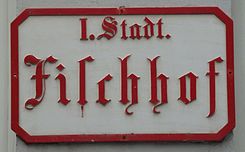Fischhof (Vienna)
| Farmers market | |
|---|---|
| Street in Vienna, Inner City | |
| Basic data | |
| place | Vienna, inner city |
| District | Inner City (1st District) |
| Created | in the 13th century |
| Newly designed | 1842, 1913 |
| Cross streets | Farmer's market , Rotgasse |
| use | |
| User groups | Car traffic , pedestrians |
| Road design | one way street |
| Technical specifications | |
| Street length | approx. 44 meters |
The Fischhof is a street in the first Viennese district , the Inner City . The name can be traced back to 1255 and refers to the fish market that was held here at the time.
history
In the Middle Ages, the Fischhof was only accessible from the Hoher Markt through an archway (where the anchor clock is today ) and from the Rotgasse through an alley. At that time it was a courtyard-like square (cura piscium). Possibly there was a fish pond here, which is mentioned as early as 1211. At the end of the 13th century, the fish market, which was previously held at the Fischhof, was moved to the western side of the Hoher Markt. Until 1483 there was a gate at the exit to Rotgasse.
The square, which was built up irregularly with larger and smaller houses, was rebuilt in 1842. The houses between Fischhof and Hohem Markt were demolished and replaced in 1861 by the Galvagnihof, which had a passage to the Hohe Markt. When the houses were demolished, remnants of Vienna's oldest curtain wall were found . In the middle of the 19th century, the Fischhof was a stand for the carriages to Gaudenzdorf and Hundsturm .
In 1912–1913 the Galvagnihof and the remains of the old Fischhof were demolished. The Ankerhof (Hoher Markt 10-12) with the Ankeruhr was created and the farmers' market was extended to the meat market . Since then the Fischhof is no longer a square, but an alley.
Location and characteristics
The Fischhof runs from the farmer's market in a south-easterly direction to Rotgasse. As an extension of the alley, the western street of the farmers' market, which recedes here, forms a continuation of the Fischhof, which is only accessible to pedestrians. The alley itself is a one-way street . There is no public transport here. Pedestrian traffic and car traffic are low. There is a Russian restaurant and a shop on the north side of the street. The buildings at Fischhof all date from the beginning of the 20th century.
Buildings
No. 1, 1A: Ankerhof
The entire southern side of the street and the southwest corner of the extension of the Fischhof beyond the farmers' market is taken up by the extensive construction complex of the Ankerhof, an insurance building. This system consists of two components. One component is free-standing on three sides between Judengasse, Hohem Markt and farmers' market with an extension of the Fischhof; the second part is completely free-standing between the Hohem Markt, Rotgasse, Fischhof and farmers' market. Both building blocks are connected by the anchor clock above the farmers' market. The neo-classical buildings were built between 1912 and 1914 by Ernst Gotthilf and Alexander Neumann . Their main addresses are Hoher Markt 10–12.
No. 2: rental house
The secessionist rental house on the northwest corner of the extended Fischhof beyond the farmers' market was built in 1910 by Anton Hein . It is at the main address, Bauernmarkt 19.
No. 3: rental house
The large, detached, late-historic rental house on three sides is located between the farmers' market, Fischhof and Rotgasse. In the middle there is an inner courtyard. It was built in 1908 in neo-baroque form by Anton Hein. The ground floor was converted in 1920 by Alex Osterberger for the imperial cinema. The building is located at the main address, Bauernmarkt 22. It is a listed building .
literature
- Richard Perger: streets, towers and bastions. The road network of the Vienna City in its development and its name. Franz Deuticke: Vienna 1991, ISBN 3-7005-4628-9 , p. 46.
- Felix Czeike (Ed.): Fischhof. In: Historisches Lexikon Wien . Volume 2, Kremayr & Scheriau, Vienna 1993, ISBN 3-218-00544-2 , pp. 318-318 ( digitized version ).
Web links
Coordinates: 48 ° 12 '39 " N , 16 ° 22' 26.5" E




